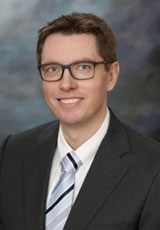Transportation Research Into Rural Driver Programs in New Brunswick
Author: Engineering Alumni Office
Posted on Nov 22, 2017
Category: Research Spotlight

You might not guess that programs for seniors in rural areas would be a hot research topic for an engineer. But that's exactly what they are for Dr. Trevor Hanson (BScCE'02, MScCE'04, PhD'10), P.Eng, and Associate Professor of Civil Engineering - and he's hoping his work will make a big impact right here in New Brunswick and around the globe.
Over the last few years, Dr. Hanson, a member of the UNB Transportation Group, has developed a novel research area into rural older adult mobility that is gaining international attention, having made several presentations at the Transportation Research Board (TRB) Annual Meeting in Washington D.C. He also recently made a site visit to Taiwan as co-chair of the Research Subcommittee of ABE60 of the United States Transportation Research (TRB) Committee on Accessible Transportation and Mobility, in preparation for an international transportation and accessibility conference (TRANSED) to be hosted there in 2018.
Hanson's research, funded through a 5-year Discovery Grant from the Natural Sciences and Engineering Research Council of Canada (NSERC) is looking at a mode of transportation that has never been explored through an engineering lens: volunteer driver programs.
“There has been lots of discussion about the safety challenges facing rural older adults who find driving difficult or impossible, but there has been much less discussion about the ways they can maintain independence if they cannot drive. It strikes me that another way to enhance safety is to ensure an alternative exists that facilities the transition from driver to passenger. Unfortunately, there are few if any alternatives to driving oneself in a rural area.”
However, he credits Katherine Freund of the Independent Transportation Network (ITN) America of Portland, Maine of developing a volunteer driver model in 2005 based on the concept of facilitating the transition from older driver to passenger, of door-to-door service. “Volunteer transportation is not a new concept, but what is new is the potential of employing these programs in a systematic way to serve broader public policy purposes by being a low-cost and acceptable solution for rural transportation. It leverages on the fact that automobiles are ever present in rural area, so how can we put the capacity of cars to better use. Not all users of volunteer driver programs are older adults, but we are interested in seeing how these programs can help older adults."

Hanson has found that in his past research and that of others, friends and family are the number one choice for those older adults who do not drive themselves, even with the availability of formalized services, such as transit. Yet with the anticipated growth of the population of older adults, it is unclear whether friends and family can satisfy the travel needs of this growing population over time. Volunteer programs can replicate the “friends and family” experience, while facilitating on-demand travel using passenger vehicles, and are already proving to be valuable services in many parts of New Brunswick.
Since beginning his research in this area, he has already seen considerable growth in the provision of organized volunteer-supplied transportation in New Brunswick, though exact figures also remains a research need. “New Brunswick has been making great strides in the development of car-based volunteer programs targeted towards rural transportation. Yet we do not know why some areas are able to successfully deploy these programs and others are not, especially since all information is case-study based. When you peel back the layers, you realize that there is a complexity to these programs that has not been previously recognized in transportation engineering and planning.”
Dr. Hanson and his graduate student, MScE candidate Matthieu Goudreau, are currently looking at a way to quantify “maturity” of successful volunteer driver programs based on indicators in certain key areas, in concert with metrics such as number of trips provided, types of trips, number of volunteers and users. “We hope to be able to predict supply and demand for services, identify locations where a new program could be successful, ultimately supporting the development of transportation planning and forecasting tools.”
Hanson also sees potential international applications. “We expect great interest in our results given the number of agencies worldwide that rely on volunteer transportation and are guided by case-study material. Volunteer driver programs are also a recognized research need within the Accessibility Transportation and Mobility Committee at TRB, and my paper, Understanding the supply of and demand for volunteer driving in Canada: Knowledge sources, gaps, and proposed framework for future research to support transportation planning for older adults has been selected for presentation at TRB for January 2018. I also expect that we will have initial results ready from Matthieu’s work for consideration for TRANSED 2018 in Taipei.”
Looking to the future, Hanson already sees an application of this approach to better understand how transportation needs of rural older adults will be met using Autonomous Vehicles (AV), a project that is currently in the proposal stage with his graduate student, David Copp, also a MScE candidate. “We feel that older adult users of volunteer driver programs may be expected to use AV in a similar way, therefore studying volunteer programs may provide us a starting point for insight on the uptake, interest and challenges with AV, and perhaps notable differences, such as the role the driver plays in supporting the user. The exciting thing is that this research, undertaken in New Brunswick, will have local and national benefits, and allows us to reach an international audience while facilitating a global connection through participation in the ABE60 Committee work at TRB.”
